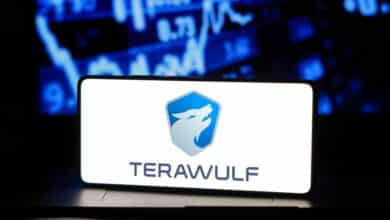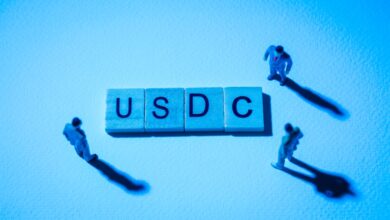Blockchain vs. Database: Key Differences

Introduction
Blockchain is the latest technology for recording digital data and binary syntax. However, even before the invention of blockchain, computers and processors were able to store, manage, and process data. Therefore, it can seem like Blockchain is just another alternative technology to allow the users to host information. Even though, blockchains and databases are technically different technologies that offer unique benefits and utility for the users. In this article, the readers are going to understand the main point of distinction between databases and blockchains and discuss which technology is better for use.
What is a Blockchain?
Blockchain is a portmanteau of two words, blocks, and chains. Blocks are the unit of transactional data that a node can carry in a single go. Blockchains are digital ledgers that are used for storing information on a network of servers without the need for an active operator. It also means that anyone hailing from any part of the world can store or access data on a blockchain at any time. Blockchains do not need centralized supervisors for operating. Blockchains also issue digital currencies like Bitcoin, Ethereum, Litecoin, etc. They can host dApps and support the DeFi ecosystem.
How does Blockchain Work?
A Blockchain is essentially a program or software. It uses Digital Ledger Technology or DLT for remaining online 24/7 without any manual operators, supervisors, or centralized regulators. Blockchains allow the users to record data such as digital transactions on each block and store it on a set of federated servers around the world. It means that blockchains are not based on a single private server. At any given time, multiple copies of the blockchain are present on different servers around the world.
Blocks on the blockchain need to be decrypted using computation power with a process that is called mining. Miners decrypt the puzzle on the block which allows them to verify the transactions on the block and add it to the blockchain. Anyone connected to a blockchain can read, track, and view all the transactions that occurred on the network from its point of origin. Blockchains issue cryptocurrencies which are fungible tokens or coins that are used to perform various financial functions such as sale, purchase, exchange, lend, borrow, and others.
Blockchains use smart contracts, which are automated programs that keep performing complex functions when the right conditions are met. Anyone with an internet connection and an operating system can join a Blockchain network without needing any approval from government agencies or banks. Blockchains remove the need to use paper money and hefty documentation for performing national or international transactions.
Private Blockchains
Private Blockchains are centralized, regulated, and permission-less networks. It means that they do not allow everyone to participate in the network activities. Only verified and approved personnel can enter a private blockchain. The users have only rights within a private blockchain based on their assigned roles. Every user can’t access all the features and data on a private blockchain. Typically, private blockchains are also not open-sourced projects.
Public Blockchains
Public Blockchains are decentralized, unregulated, and permissioned networks. Public blockchains allow anyone hailing from any part of the world to participate and join the network. Public blockchains can use a Proof-of-work or Proof-of-Stake mechanism for verification of transactions on the network. Public blockchains are open-sourced which means that any developer hailing can access the source code and use it at their discretion. Public Blockchains are also called trusted networks that use smart contracts to remove frauds.
Hybrid Blockchains
Hybrid Blockchains are networks that are part public and part private. Such a blockchain has some of its functions and sections under the control of a private enterprise. Meanwhile, the larger portion is permissioned and dedicated to consumers or public users. The benefit of a hybrid blockchain is that private organizations do not have the power to change or alter any financial details or data that is present on such a network.
Consortium Blockchains
A Consortium Blockchain is a collective or collaborative DLT network that is used by several commercial enterprises as a junction. The junction is created to make different digital functions such as transfer of supply chain data, making international payments, communications, etc. It is also called a Federated blockchain. The authority of the Consortium blockchain is distributed among several commercial participants and it can keep the sensitive data private.
What is a Database?
These days so many people use social media and email accounts. The countless websites on the internet allow users to create their unique accounts, upload files, and perform different activities. At the same time, none of this information is saved on the computer or mobile phone. That is because these programs and websites have a private database. A database is also a type of program that allows a company or a private individual to store, read, write, and manage all their data. However, unlike blockchains databases are based on a singular server.
In most cases, companies keep backup data with copies of the original database in case of emergencies. Furthermore, all the data present in a database is centralized and is readily accessible to users based on the level of clearance.
How does a Database Work?
A database is an early form of a blockchain that is also a type of computer program that allows the users to perform different functions. The database not only allows the users to exchange information but also stores particulars using a single server. With SQL or Structured Query Language, it is possible to access all the information present in a database. The database has a hierarchical system which means that only authorized people can gain access to different levels and management rights. The database information is stored in the form of a table with fields for recording different arrays and sets of data called attributes.
Types of Databases
Hierarchical Database
Hierarchical databases are like trees that require users to pass a level of hierarchy to gain access to different levels. The nodes present in a database are arranged in parent and child relationships. There are several levels of limitations present in a hierarchical database which means that it is dedicated to specified usages and offers management options for verified and authorized users.
Network Database
Network databases are also a type of hierarchical database that is present in a tree-like structure and contain limitations at every level. However, the child nodes in network databases can have more than one parent node. Network databases are integrated systems that allow the flow of information in a web-like manner.
Object-Oriented Database
Object-oriented databases are systems that present data in the form of an object. These objects can correlate with multiple other objects. Object-oriented databases are created with object-oriented programming languages.
Single-file Database
The single-file or flat-file database is a simple database that contains information in the form of a plain text file. Furthermore, the information on the text file is present in a series of lines where each line represents one record. A flat-data file cannot contain more than one tablet relation and it is very rudimentary.
Multi-file Database
Multi-file databases or relational databases have multiple tablets of data present in streams of rows and columns. These rows and columns are connected with the use of special key fields. A multi-file database can offer functions like upgrading, creating, editing, deleting, and reading. Relational databases use SQL for creating an interactive user interface for easy and universal access.
NoSQL Database
A NoSQL or non-relational database allows the users to store and manage large amounts of data. The non-relational databases can manipulate unstructured and semi-structured data. They can enable functions like key-value storage, graph-based statistics, and document storage.
When it comes to their basic functionality it can seem like private blockchains and databases are the same entities. However, they have some level of unique attributes depending on their functionalities and technical structure. A private blockchain and a database are both centralized entities and only authorized users can access them. At the same time, databases allow the centralized authority to delete the information while private blockchains only grant read and write options to the highest authority.
However, a private blockchain is still a unique technology that offers the security of data using cryptography. Meanwhile, databases are less secure in comparison to private blockchains. Databases do not have any data integrity (accuracy, completion, consistency) while private blockchain contains it. Private Blockchains are based on a peer-to-peer model while the architecture of the database is based on a client-server model. Private Blockchains can also be partially decentralized while databases are wholly centralized systems.
Key Differences Between Blockchain and Database
Now that the basic definitions and the core structure of Blockchains and databases have been established, it is time to explore their key differences. At the outset, the functionality of blockchains and databases can seem very similar. However, they have a lot of visible points of distinction that are mentioned under:
Authority
The main function of both databases and blockchains is to store data. However, Blockchains are usually decentralized while databases are centralized. On account of decentralization, blockchains have a better level of security and data protection in comparison to databases. Decentralized applications can keep operating with lesser human interaction which is considered the next step in programming. It also means that everyone using a blockchain has the same level of access and authority in the network.
Meanwhile, since databases are centralized the rights of accessing and manipulating the data present on them are reserved with the administrators. Administrators on a database also can assign a limited level of access to other users such as node validators and editors etc. However, administrative rights are kept limited to make sure that the database remains secure and away from the reach of hackers or threat actors.
Architecture
The infrastructure of a database is based on a client-server model. It means that users are allowed to access a certain part of the database such as the user interface. The architecture of the databases makes it ideal for small and big-scale operations and servers are present to fulfill the role of a centralized processing unit. The clients on the database can communicate with each other and retain the record on the server. At the same time, databases also can secure communication with secure connection channels.
On the other hand, blockchains use the Peer-to-peer model at their core. It means that one user can conduct transactions with the other user with encrypted protocols. Blockchains also depend on consensus mechanisms like PoW for verification of the decentralized nodes on the network. There is no need for an administrator to maintain the data on a blockchain-like database. All the functions on the blockchains are carried out by smart contracts.
Data Processing
Data processing methods on blockchain and databases are completely different from each other. The data on a database can be stored and used with relative ease following the principles of CRUD (Create, Read, Update, and Delete). It also means that the information present on a database can be removed or changed by the administrator at their discretion. Meanwhile, Blockchains store data by using DLT. It means that copies of all the verified transactions are sent to every single server of the blockchain. Blockchain allows only read and write functions, it means that no one can change or alter the information present on a blockchain.
Transparency
Databases are usually hierarchical networks which mean that they discourage all users from accessing its source code or information present on it. Only the administrator at the top can edit, upgrade, and change database information. The users of the databases can only access the functions that have been approved by an administrator. Database administrators ensure that there are considerable limitations on the network to keep it secure.
On the other hand, blockchains are decentralized and it means that all the information present on the network is accessible to everyone. With a decentralized and open-sourced blockchain, all the source code and the transaction data present on the network is accessible to every. In the case of private blockchains, users may be unable to access all the data but even the administrator cannot delete or manipulate the data on it.
Immutability
Databases are good for serving as the center of information relating to a particular system or computer program. However, the administrators of a database can make any changes in the architecture or the information at any time. In the case of a database, the administrator also does not need any approval from the users to make such changes.
In contrast, a blockchain does not allow any user to change or alter any user to make changes to its core structure or digital ledger. Since information is present in the form of thousands of copies across different servers around the world, it means that a developer will need a massive amount of computation power at their disposal to be able to change or alter the said information which is currently a nearly impossible feat. Blockchain developers can however add second-layer projects to enhance their performance rather than changing their main frame.
Operating Costs
Databases are cheaper for implementation since blockchains are a relatively new technology. Databases have been around for decades and there are plenty of software engineers who can create, manage, and upgrade databases. While the implementation costs for a database are smaller, the maintenance and operational costs are higher. Since databases require constant human supervision and they also require active monitoring to make sure that they are secure against foreign threats.
On the other hand, blockchains are safe and secure networks and they are encrypted which makes it impossible for foreign actors to launch an attack. At the same time, due to a lack of blockchain developers, the pay grade is higher in comparison to others. Meanwhile, database engineers are more readily and cheaply available in comparison. Companies that wish to create a decentralized application have to spend considerably higher on talent acquisition.
Performance
The performance and processing speed of a database are higher than blockchain. However, in this case, the higher speed is not always the best possible output. Since blockchains use cryptography for securing the information present on the network, they take more time to verify each transaction. It means that despite being slower, all the data present on a blockchain is many folds more secure in comparison to the records on a database. Blockchains use the Signature verification method by creating a unique code to confirm the authenticity of every new transaction.
Blockchains also employ different consensus models that allow them to decrypt the code and add the new block to the network after verification. The transactions present on a blockchain are verified by every single node on the network which requires more time. However, since blockchains are relatively new technologies, it means that developers are constantly working on improving the performance by increasing the blocksize or upgrading the consensus models.
Utility
Databases are used for facilitating applications, software, or sites that require a steady flow of information. Databases are useful for storing confidential information. They can perform fast online transactions such as bank wires. They do not have any data verification mechanism.
Databases depend on relational information and work as standalone applications. On the other hand, Blockchains are used for the transfer of value, performing financial functions, decentralized applications, voting, storage, data verification, community-governed networks, and issuing cryptocurrencies.
Conclusion
Databases and blockchains are two unique and important technologies. Each type of technology offers a specified function and in some ways, both have an edge over the other. However, it is possible that in the future all databases are replaced with blockchains if the developers can overcome issues like scalability, decentralization, and transaction speed, among others.
Tokenhell produces content exposure for over 5,000 crypto companies and you can be one of them too! Contact at info@tokenhell.com if you have any questions. Cryptocurrencies are highly volatile, conduct your own research before making any investment decisions. Some of the posts on this website are guest posts or paid posts that are not written by Tokenhell authors (namely Crypto Cable , Sponsored Articles and Press Release content) and the views expressed in these types of posts do not reflect the views of this website. Tokenhell is not responsible for the content, accuracy, quality, advertising, products or any other content or banners (ad space) posted on the site. Read full terms and conditions / disclaimer.







